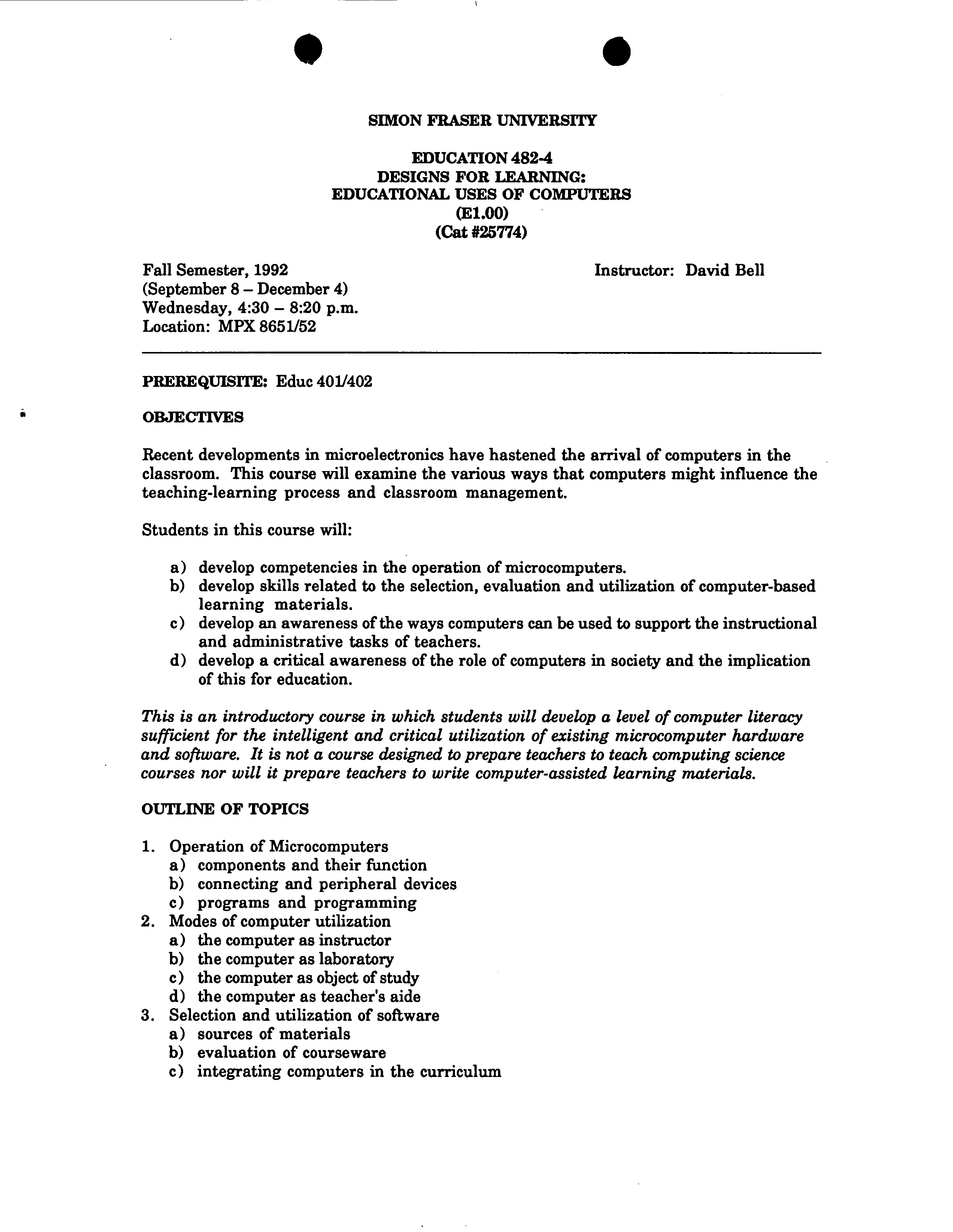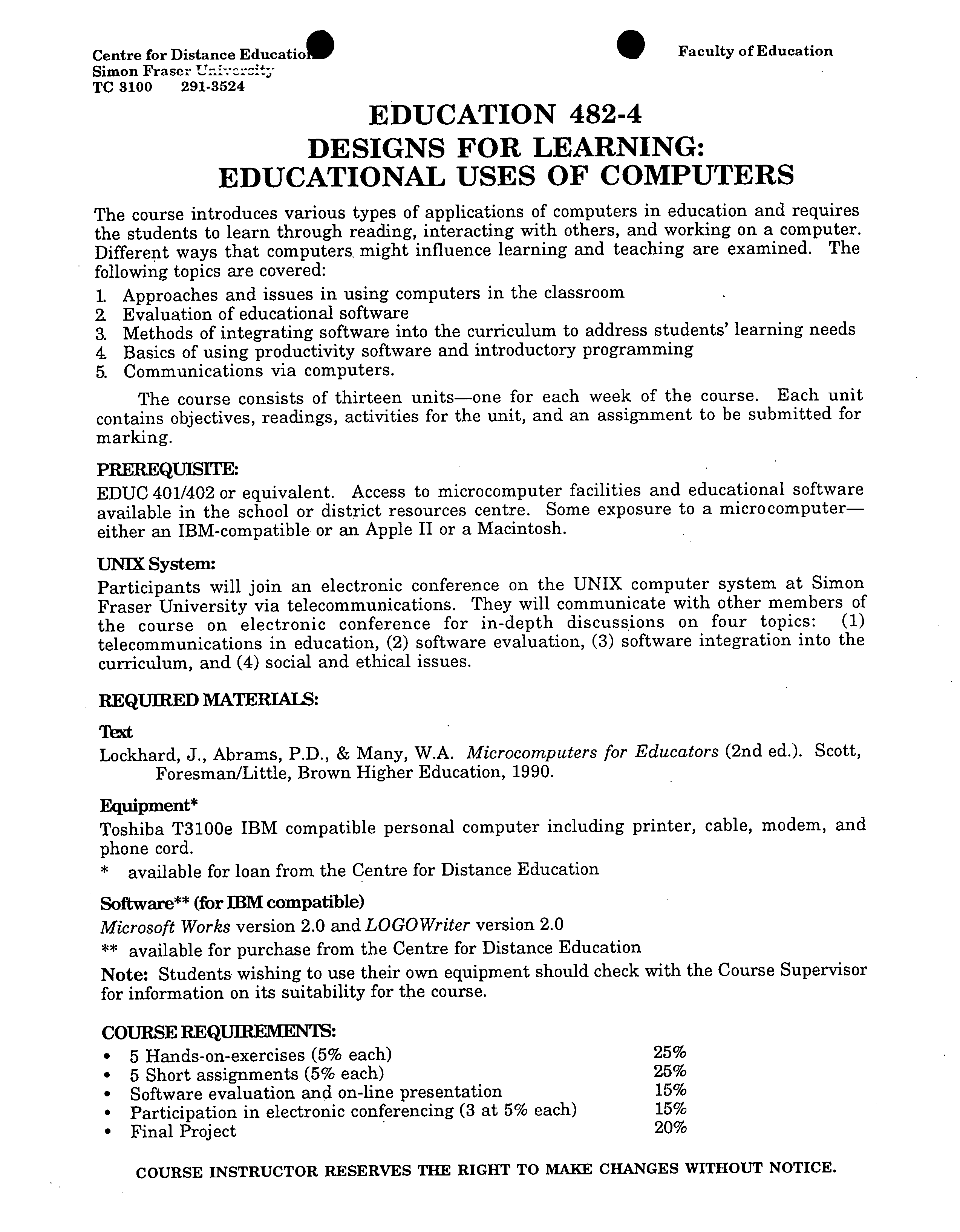SIMON FRASER UNIVERSITY
EDUCATION 482-4
?
DESIGNS FOR LEARNING:
?
EDUCATIONAL USES OF COMPUTERS ?
(E1.O0)
?
(Cat #25774)
Fall Semester, 1992
?
Instructor: David Bell
(September 8— December 4)
Wednesday, 4:30 - 8:20 p.m.
Location: MPX 8651/52
PREREQUISITE:
Educ 4011402
Recent developments in microelectronics have hastened the arrival of computers in the
classroom. This course will examine the various ways that computers might influence the
teaching-learning process and classroom management.
Students in this course will:
a)
develop competencies in the operation of microcomputers.
b)
develop skills related to the selection, evaluation and utilization of computer-based
learning materials.
c)
develop an awareness of the ways computers can be used to support the instructional
and administrative tasks of teachers.
d)
develop a critical awareness of the role of computers in society and the implication
of this for education.
This is an introductory course in which students will develop a level of computer literacy
suffi
cient
for the intelligent and critical utilization of existing microcomputer hardware
and
software.
It is not a course designed to prepare teachers to teach computing science
courses nor will it prepare teachers to write computer-assisted learning materials.
OUTLINE OF TOPICS
1. Operation of Microcomputers
a)
components and their function
b)
connecting and peripheral devices
c)
programs and programming
2. Modes of computer utilization
a)
the computer as instructor
b)
the computer as laboratory
c)
the computer as object of study
d)
the computer as teacher's aide
3. Selection and utilization of software
a)
sources of materials
b)
evaluation of courseware
c)
integrating computers in the curriculum
I
?
O
4. Computer literacy
a)
print and non-print materials on computers
b)
role of computers in schools and society
c)
status of computers in B.C. schools
d)
use and misuse of computers in education
COURSE ACTIVITIES
Course activities will consist of lectures, demonstrations, readings and laboratories.
EVALUATION
Evaluation will be based on:
1.
a paper reviewing the application of computers in a selected curriculum area (10 pages)
2.
a critical evaluation of a piece of software (software review) (2-3 pages)
3.
short tests related to the lectures and readings
4.
demonstration of computer operating skills
REQUIRED TEXTBOOKS
A set of readings will be available from the Instructor at the first class meeting.
Centre for Distance Educatio
?
I ?
Faculty of Education
Simon Fraser ivcy
TC 3100
?
291-3524
EDUCATION 482-4
DESIGNS FOR LEARNING:
?
EDUCATIONAL USES OF COMPUTERS
The course introduces various types of applications of computers in education and requires
the students to learn through reading, interacting with others, and working on a computer.
Different ways that computers. might influence learning and teaching are examined. The
following topics are covered:
1 Approaches and issues in using computers in the classroom
2 Evaluation of educational software
3. Methods of integrating software into the curriculum to address students' learning needs
4 Basics of using productivity software and introductory programming
5. Communications via computers.
The course consists of thirteen units—one for each week of the course. Each unit
contains objectives, readings, activities for the unit, and an assignment to be submitted for
marking.
PREREQUISITE:
EDUC 401/402 or equivalent. Access to microcomputer facilities and educational software
available in the school or district resources centre. Some exposure to a microcomputer—
either an IBM-compatible or an Apple II or a Macintosh.
UNIX System:
Participants will join an electronic conference on the UNIX computer system at Simon
Fraser University via telecommunications. They will communicate with other members of
the course on electronic conference for in-depth discussions on four topics: (1)
telecommunications in education, (2) software evaluation, (3) software integration into the
curriculum, and (4) social and ethical issues.
REQUIRED MATERIALS:
Ted
Lockhard, J., Abrams, P.D., & Many, W.A.
Microcomputers for Educators
(2nd ed.). Scott,
ForesmanlLittle, Brown Higher Education, 1990.
Equipment*
Toshiba T3100e IBM compatible personal computer including printer, cable, modem, and
phone cord.
* available for loan from the Centre for Distance Education
Software (for IBM compatible)
Microsoft Works
version 2.0 and
LOGO Writer
version 2.0
** available for purchase from the Centre for Distance Education
Note: Students wishing to use their own equipment should check with the Course Supervisor
for information on its suitability for the course.
COURSE REQUIREMENI'S:
•
5 Hands-on-exercises (5% each)
?
25%
• 5 Short assignments (5% each)
?
25%
• Software evaluation and on-line presentation
?
15%
• Participation in electronic conferencing (3 at 5% each)
?
15%
• Final Project
?
20%
COURSE INSTRUCTOR RESERVES THE RIGHT TO MAKE CHANGES WITHOUT NOTICE.



